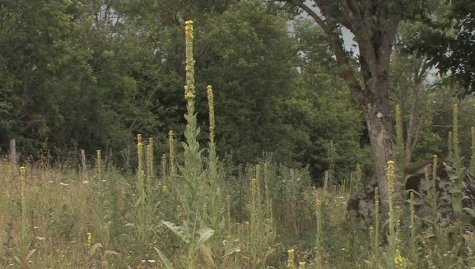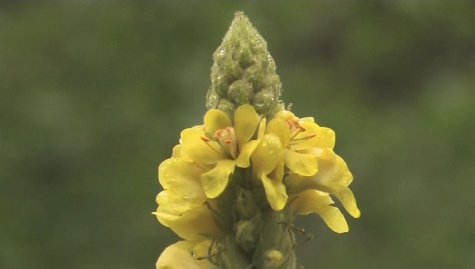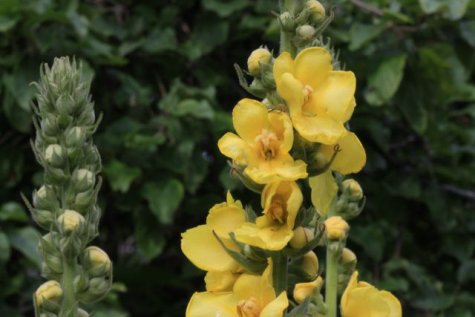Interview by: Helen Arusoo, journal Loodusesõber
Images of mullein from the film
Translation: Liis

Going to the opening night of Rein Maran’s film "Keeper of Seven Powers” I was eager to find out how it could be possible to bring together the portraits of 33 plants –this is the number of species in camera view – into a whole?
Films about plants are rare, and particularly those with many plant species. The danger of ending up with a series of encyclopaedic images surely lurks in every film creator’s mind. But it did not happen with Rein Maran’s film. How come?
The film is an invitation to a sacred grove, hiis. This film is not only about plants but also about people. The world of plants is open for discovery by us all. We can find help there when we are stressed by the tangles of relations and problems in everyday life. In herbs we can find power, we should approach them as we approach a sanctum.
Music plays an important part in the film. You can note in different cults that music has always been made in sacred places. Music is the higher sphere, with power to inspire particular feelings. I set a specific task for the musicians: that they should make such music for the film that would evoke these feelings – music that might sound in a sacred grove. In old times people went to the grove, but now in our times when we have less contact with the life surrounding us – now the whole of untouched nature can be a kind of sanctum for us, where we can find the inner balance for ourselves and for our relations with others.
The music, I have to admit, was complicated to make. I worked for a long time with selecting it. I looked for composers for whom a sacred grove would be a natural and familiar thing. It wasn’t easy for them either to work with me, they probably swore at me behind my back (Rein Marand smiles – H.A.)- Since I had listened to all of Mikk’s (Sarv – H.A.) and Aleksander Sunten’s works in beforehand, one by one, I decded to bring these two together. And Tuule Kann, whom I value as a musician with a true heart, completed the whole. I searched for this feeling of nature’s sacredness in the music; and of course there were parts that I wasn’t happy with and they went back and forth many times.

The musicians didn’t sing old regi songs in the film, why? That was really music for the sanctum. But in everything – the voices of Tuule Kann, Aleksander Sünten and Mikk Sarv, the sounds of kantele and flutes, the regi songs were there.
The melodies of the musicians were born from old folk songs but the music itself is music on the theme of the old regi songs. Tuule first saw the whole film, then improvised at length, later we chose parts of the music for the film. Most modern people aren’t very comfortable with the regi songs themselves.
An image from the film: white clouds sail across a blue sky, in the background drum beats. But the drum wasn’t really one of our "own”instruments?
The music has another task in the film besides evoking a feeling of sacredness: it creates a pause. A pause is also an element of music. The heart beats of the shaman drum and the endless flow of the clouds tell about the flow of time, I hope. We often live in the present moment so that we don’t see our environment and the time as values of life.
Altogether this is an unconventional film. We are usually taught: „Films can’t be made like this”. No line of events nor story. All these leaps back and forth in time (in the film we see plants in spring, summer, autumn – H.A.). Maybe the viewer discovers his own capacity to make these leaps in time and space in his mind: seeing plants close up, and at the same time imagining them both in full flower and setting seed. The clouds also marked such time leaps in the life cycle of some of the plants.

How did you select these 33 plants? There is the marigold, a herb of later times, side by side with for instance the oak, an ancient folk medicine plant?
It was truly hard work! We made many different lists: the plants that are most often mentioned in old sayings and texts, those that are used in present-day Europe, those that are most often grown and gathered today etc. Setting these lists beside each other we at last made the final choice. One point was also to achieve a visual variety. And yet one and the other beautiful plant had to be left out. For instance there wasn’t room for my beloved cornflower – it is good for the eyes – in the film. We did record some cuts, just in case, but the final selection turned out differently.
The film as a whole was a complicated task, not one of those single-solution things. For each plant we had to find its own approach. I plagued many people with my questions: scientists, medical plant specialists and growers, not to speak of pharmacists. In talking to them all this idea of the film as it is now crystallized.
Where can we see "Keeper of Seven Powers”?
Probably in ETV [Estonian state TV]. A DVD with texts in four languages is also in process; with the DVD goes a folder with presentations of all the plants in the film.
The interview above is published in the June issue of the journal Loodusesõber.
Great mullein, also Aaron's rod (Verbascum thapsus).
Regi songs: Estonian "regilaulud", also known as runic or runo songs.
Sacred grove, grove: Estonian "hiis" is maybe less tied to formal rites and priests than "sacred grove" implies.











